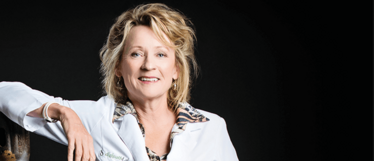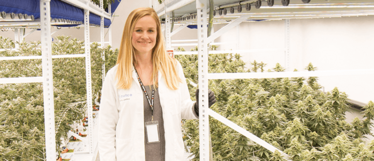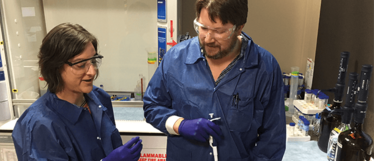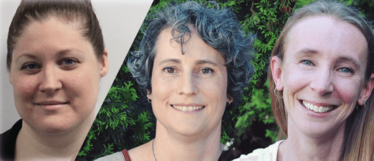Smashing the grass ceiling
The cannabis industry is reported to have a greater than average number of women in executive level positions. But what about women working in cannabis science? With most scientific fields still struggling with equity, we wanted to shine a spotlight on the female scientists shaping this emerging sector. Here, we speak with seven inspiring women blazing a trail in pesticide testing, cultivation and classification to find out how they survive and thrive in this fast-paced and rapidly changing field.
Cindy Orser, Allison Justice, Julie Kowalski, Jaclyn Thomson, Clare Maloney, Katie Maloney, Brianna Cassidy |
A Class Act
By Cindy Orser

Over the course of my career, I’ve worked in microbiology, genetics, biochemistry, biotechnology and cancer research. But it was while developing rapid diagnostics for biological toxins at ASDx Biosystems, a company I started in 2012 in Boulder, Colorado, that I was asked by a headhunter if I’d be interested in designing, building and staffing a medical cannabis testing lab in Las Vegas, Nevada. Today, I am the Chief Science Officer at the lab I set up – Digipath Labs. Entering the cannabis industry, I immediately saw that there was a lot of false information out there, as well as a lack of transparency at the dispensary level. My motivation is to educate cannabis users, so they can make more informed choices about what they put into their bodies. Prior to the cannabis industry, my career has been long and extremely varied, spanning various disciplines and subjects, where I have always strived to bring an innovative perspective.
The “terpene project”
Some of the most common misinformation in the cannabis industry is related to strain naming. There’s no agronomic convention used in naming cannabis strains, whereby you register your cultivar and establish verification criteria. The ambiguity allows for a lot of confusion – and even fraud. Thankfully, a number of influential groups are now calling for the industry to embrace standard naming conventions for cultivars.
I wanted to see just how much diversity in cannabis strains there was, so we started doing large-scale data analytics based on the samples we are sent for testing. We are now working on “the terpene project”, proposing a new classification scheme for cannabis based on terpene chemoprofiles. For one project, we looked at 2,200 individual flower samples, and across those samples there were 403 different strain names. By characterizing clusters based on their terpene chemoprofiles, we showed that there were really only three groups, and only 28 strains that could be called unique. Now, I’m working with scientists in other US states using the same in-depth data analysis.
As well as using terpenes to identify strains, I have a lot of interest in formulating terpenes, because I think they are a huge component in the “entourage effect.” Also, there is more freedom to study the terpenes because they don’t sit under that Schedule 1 stigma. As the cannabis industry matures and as we move towards evidence-based medicine, there is an absolute need for confidence and reproducibility in what people are growing.
Testing for transparency
I would like to streamline the required testing for cannabis – Nevada has the most rigorous testing requirements of any state, and there is some overlap in the tests we have to carry out. Cannabis is already a very challenging matrix to work with and the level of testing we do is very time-consuming and expensive. Certainly, no food product is tested to this extent in Nevada or elsewhere.
As cannabis enters the global marketplace and the path towards evidence-based medicine, standardized methods for cannabis testing are inevitable. Cannabis and cannabis-based products have to be reproducible, and I think we’re going to move further away from the flower and more toward all-plant extracts. Cannabis presents many opportunities, so it’s an exciting field to be in – if the federal regulations get relaxed, it’s going to be amazing.
On Women in Cannabis
In my experience, there is a high proportion of female scientists in significant roles in the cannabis industry. Because the industry was so new, there wasn’t time for male domination – it was a level playing field, and there were a lot of mature, well-educated, capable women scientists who saw the opportunity and seized it.
Plant–Life Balance
With Allison Justice

After I graduated with a PhD in Plant and Environmental Science, I began producing, rearing and selling beneficial nematodes. While I was consulting with greenhouse facilities on how to use nematodes properly, I began to get calls from cannabis companies – as it turns out, they have very similar pest problems to other areas of horticulture. I started to realize how much was lacking in cannabis research and development and saw there was an out-of-this-world opportunity to adopt different methods to produce better, cleaner and faster-growing plants. I’ve been growing plants since I was one year old – so for me, cannabis is just a different plant.
I am now VP of cultivation at OutCo. I oversee the cultivation facilities and am responsible for the design and planning of our grow facilities. We currently have a mid-size indoor grow at our headquarters in San Diego, a small outdoor grow in Mendocino and are planning to open a large-scale indoor grow in Long Beach by the end of the year.
How does your garden grow?
The science is the most rewarding part of my role. It’s exciting for me to talk to industry veterans and strengthen the science behind what they’ve been doing up to now. Despite its obvious links to horticulture, cannabis operates as a whole different industry. Many growers have been forced to work in secret for much of their career and aren’t always receptive to new ways of doing things, but I work on cultivating respect (no pun intended), and have tried to show that I just want to help.
In fact, growing cannabis – from sticking the cutting to harvest – is very similar to other plants. It needs the same 16 essential nutrients, and has a very similar range in temperature and humidity requirements as a poinsettia. Things get trickier post-harvest, when we have to figure out how to preserve the terpenes and allow time for all the enzymatic processes to happen, and yet dry the plant quickly enough to prevent the growth of destructive microbes. It’s a delicate balance, yet of huge importance.
Our small San Diego facility has been used as a true R&D facility with the goal of taking our extensive updates, upgrades and optimizations to our larger expansion facilities. Some examples of these transformations are double-stacked rolling benches lit by LEDs, customized fertility programs, optimized scheduling, and a standard integrated pest management program.
Bugs with benefits
When protecting against destructive pests, growing indoors is much more difficult than growing outdoors. Outdoors, plants are exposed, so natural predators take care of some pests. Indoors, a pest may come into a protected, enclosed environment and “explode” in numbers – and there are no natural predators. Californian regulations mean that you can’t spray synthetic pesticides as they will show up in the end product, so you have to come up with more creative methods. Nematodes or beneficial insects are our first line of defense. We apply different species of nematodes and predator mites. The nematodes take care of the plant roots and the predator mites protect the leaves.
Sustainable or organic cultivation is a much harder process than using chemical controls. You have to know the life cycle of the pest, and the life cycle of your beneficial – then work out how often to apply it. With a synthetic pesticide, you have the ability to be lazy – you spray and you leave it!
If applied preventively, beneficial insects are as effective as synthetic pesticides, but less so if you’re trying to clean up an existing problem. A lot of these pests are microscopic, so you need to have somebody in there all the time, taking random samples. You don’t want to wait until you see the damage before you begin treatment.
On Women in Cannabis
In the US, there is an impressive number of women in higher-level positions in cannabis – but not in cultivation. That’s still male-dominated, as it is across agriculture. In other fields, such as marketing or dispensary management, there are more women compared with scientific fields. And they’re doing a fantastic job!
My mom has been an incredible role model to me. She had a 200-acre tree farm, and, growing up, I watched her lead a crew of men and work really hard in a male-dominated industry. She taught me how to change a tire on a tractor; and she taught me I should aim to be on top because of my knowledge. I think she struggled at times, as she’s had to deal with people who believe women are less capable. But she has always told me to keep my head up, because results speak for themselves. I’ve always taken that to heart.
Rising To The Challenge
With Julie Kowalski

At school, science was always a challenging subject for me. But I’m stubborn, and I decided I was going to stick with it and see if I could get better. Then, I really started to enjoy it. I ended up in analytical chemistry specifically because I’ve always liked to “monkey around” with equipment.
I was at chromatography company Restek, working on tools for food and environmental analysis, when we started getting calls from customers asking if we had any methods for cannabis. Around the same time my colleague, Jack Cochran, brought a magazine article about pesticides in marijuana to work. This “grass roots” pressure grew steadily, and eventually the company started to market to cannabis labs.
I soon realized how many challenges the industry was facing – and my stubbornness came into play once more. I felt there were better methods out there; why shouldn’t I get involved in developing them? Trace Analytics were (and still are) engaged in early-stage development, which was really attractive to me.
I would say I’m the “technical person” at Trace Analytics. Scientific Director is, a lot of the time, an “on-paper” job… But I still love being hands on in the lab, and this job gives me that balance. I’m in the lab almost every day, developing methods, and helping out with client samples. In a broader sense, we’re trying to refine our methods and keep elevating our standards. That’s a major focus for me – to ensure we continue to do really solid work.
I did feel slightly nervous about making the move into cannabis – the fact that it’s still federally illegal in the US means there is an obvious lack of stability compared with more established markets. I have had to learn to “roll with the punches” a little bit more than I would naturally. Also, there’s a lot of “on-the-fly” developing; any product you can think of, people are trying to put cannabis extract into it. We get flowers, cannabis plant material, extracts, edibles, personal care products... And on one memorable occasion we were asked to analyze cannabis-containing personal lubricants!
Value-added tests
Our clients are also very different to those you might deal with in established markets, such as food or environment. For the average client in cannabis, testing is something that they’re still wrapping their head around. Some find it hard to understand the importance of testing, but we are always respectful, and talk through any issues.
In the lab, much of what we do is compliance testing – potency testing or testing cannabinoid content. We also do residual solvents, extracts, and so on, using GC-MS. We do terpene analysis – not required by Washington State – via headspace GC-MS. We do pesticides by LC-triple-quad MS, as well as water activity, moisture content and microbiological testing.
The plant itself is challenging, but trace level determination of pesticides can be particularly complex.
You meet these challenges by developing methods that are specific to the issues. For example, I have been spending a lot of time working with scientists at other labs on sample preparation so we can take a more targeted approach. We bounce ideas off each other and work with vendors on custom products. It’s good to have a community that is willing to help out.
Historically, cannabis labs have been very secretive about their methods, but that is not how science works. If we’re all doing the same methods in private, my fear is that in 20 years there’ll only be repetition, and no advancement. But we are turning a corner; I’ve been reaching out and have found people that are of a more collaborative mindset.
In a few years’ time, if I can help get the analytical testing to a really robust level – on a par with other industries – I would be totally satisfied. I know there is a better sample preparation method out there for doing pesticides in cannabis. And being the stubborn person I am, I’m determined to find it!
On Women in Cannabis
Women are quite well represented in cannabis science right now – but my personal feeling is that as the industry as a whole matures, and more established “traditional” companies come into play, the percentage of women will drop to the levels seen in other analytical markets: environmental, food, pharmaceutical.
Despite having really good direct managers and mentors, I have still had to be more assertive than men in the same position to make sure I’m listened to. As a woman, you’re taken more seriously as you get older, so now in my early 40s I don’t have to fight for a voice as much as I used to.
The advantage in the cannabis industry is that everyone is hungry for knowledge – they are more concerned about acquiring the information than who the information comes from. It doesn’t matter if you’re a man or woman, as long as you know something helpful.
On The Grapevine
With Jaclyn Thomson, Katie Maloney and Clare Maloney

How did you come to work in cannabis science?
Jaclyn Thomson: My fascination with science began at a young age, but I became interested in the cannabis industry as legalization for medical use became a reality. I researched the unique properties and characteristics of the plant while working as the Quality Assurance Manager at a natural health product manufacturer, where I acquired a great deal of knowledge of licensing, regulatory affairs, and various manufacturing processes. I then joined Northern Vine in time to begin the process of outfitting the lab and developing testing methods.
Katie Maloney: A friend of a friend involved in the cannabis industry was looking for chemists, and I was interested in a new challenge! I joined Northern Vine at a time when we were pursuing our controlled substances license for the purpose of conducting quality control testing of legal cannabis in Canada.
Clare Maloney: My analytical chemistry career has led me to work in a wide variety of industries, but I was invited to join the company originally because of my experience in pharmaceutical analysis, specifically some of the generalized testing that is applied to all pharmaceuticals, and which I could adapt to cannabis. It was also an opportunity to continue collaborating with my cousin, Katie Maloney, who is a great chemist!
What is your role?
JT: As the Director of Research and Development, I oversee all laboratory testing, test method development, and validation as well as all R&D, quality management, and any scientific processes in general. I love to solve problems and educate myself, but I also enjoy teaching others to help them understand new and exciting things. My role really gives me the best of both worlds.
KM: I am the Senior Scientist in the chemistry lab. I am currently responsible for developing and validating our testing methods, as well as conducting some R&D. I love working in the lab and solving research problems.
CM: As Scientist, I work on method development, validation, and laboratory operations. I have had extensive experience in operations, and my experiences in other areas of analytical chemistry offer a bed of practical knowledge for method development.
What interests you about the cannabis field?
JT: We are all excited at the wide variety of research that remains to be done on a plant that has been a part of the human experience for so many thousands of years. We are lucky to be part of an organization that shares in that excitement, and is supporting research not only into analytical methodology, but into many other aspects of the effects, uses, and benefits that cannabis can provide, to say nothing of the more practical side of extraction, production, and delivery systems. The unique combinations of components in the cannabis matrix, variations in cannabis strain, and variations in product type result in a sizable knowledge gap that we are looking to fill. Everything is new and that’s exciting!
How has the field changed since you’ve been working in cannabis?
JT: Initially, testing was a service only available to Licensed Producers, but now individual patients have a means of ensuring their product’s potency and safety. The demand for information about all aspects of research into cannabis continues to rise as more questions are raised about its actual therapeutic uses, and literally millions more potential consumers come into play with the legalization of recreational use in Canada. We believe that the genesis of this information gathering will lie in being able to accurately analyze the plant, and the products made from it.
What do you find most rewarding about your role?
JT: The opportunity to be involved with establishing a testing facility from the ground up has been a very challenging, but educational and rewarding experience. I enjoy being able to use my skills and knowledge to move the process forward as efficiently as possible. I also enjoy educating others, both at the corporate and operational level, about the science behind the testing and all things cannabis science! I work with a fantastic group of people and that really gets me excited to come to work every day.
KM: I really enjoy our work environment and culture, too. We are supportive, encouraging, and united in our goals to produce high-quality work, and address problems and research questions. To have a workplace that fosters problem-solving is very gratifying.
CM: We work in a very dynamic environment, and encounter many challenges, questions, and new avenues of enquiry every day. We have a pretty collaborative approach, and I feel like I can bring to bear not only the technical expertise that I’ve gained through my career, but also some practical knowledge when it comes to problem solving.
How does it compare with other industries you have worked in?
CM: The cannabis industry seems a lot more competitive, a lot more dynamic, and has a much more diverse personality type than most other industries. It’s ever-changing and running at a million miles a minute.
JT: The discussion of the role of women in science-based industry is definitely still relevant. The emerging cannabis industry has huge potential for growth, and women have a unique opportunity to make a significant contribution. Women continue to be somewhat under-represented in science, but increasing numbers are confidently pursuing advanced education and taking on higher profile leadership roles in a variety of industries. We have all had the pleasure of working with knowledgeable, experienced and talented women over the course of our careers. As women in science, we are looking forward to a more inclusive future, and hope to act as positive role models for girls and young women considering a career in science.
How important have your female role models been?
JT: Female role models in science are very important – I believe this has contributed to an increasing number of highly educated and skilled women assuming leadership roles. In addition to mentoring me through my research, my PhD supervisor taught me many management, supervisory and other skills, which are useful in my current role. She really inspired me to be the scientist and leader that I am today.
KM: I have been lucky enough to spend my scientific career surrounded by talented and accomplished women. They have shown me that I should have high expectations of myself, and that I can meet them day after day.
CM: My parents were both chemists and my mom was an analytical chemist, so I have followed in her footsteps. I would say I was inspired by her approach to life in general, not necessarily her choice of career. It makes me happy to see people doing what they want to do, and being appropriately compensated for it, regardless of gender.
What changes would you like to see in the field?
KM: We’re looking forward to a broader knowledge base and deeper understanding of the chemical properties and therapeutic effects of cannabis. If the past year has been any indication, then we believe we’ll have enough new challenges and opportunities to keep us interested for years!
Playing The Game
With Brianna Cassidy

My high school teacher, Lisa Devillez, was my first role model in chemistry. I started an advanced placement class with her, working on chemistry for a couple of hours before class – she was there at 6 am every day to tutor her students! It was a difficult subject, but I found that I could be really good at it when I worked hard. The sense of perseverance and accomplishment really drew me to chemistry, and later I was attracted to analytical chemistry by the attention to detail it required.
Cracking the cannabis code
I got into cannabis because I’m open-minded. The fact that Brian Strasnick, President and CEO of CDX Analytics, funded the entire suite of brand new instrumentation I recommended helped too! Now, CDX scientists have the greatest “toy box” for cannabis analysis in the world, which includes gas chromatographic and liquid chromatographic triple-quadrupole mass spectrometers capable of detecting pesticides in cannabis down to ten parts per billion, the lowest limit in United States cannabis regulation. We also have an inductively coupled plasma mass spectrometer to detect metals that have been found to bioaccumulate in the plants, and quantitative polymerase chain reaction technology with a robotic liquid handler on the front end for microbial analysis. These are just a few of the big players that allow us to meet the challenging testing requirements in Massachusetts.
I took two art minors while majoring in chemistry and this reinforcement of creativity really gave me an edge in the chemistry laboratory. I wasn’t afraid to go outside of the protocol and try something I thought would be more efficient or accurate. It allowed me to work with difficult matrices where standard methods won’t cut it – which has stood me in good stead for cannabis science. I have analyzed trace-level contaminants in fish, dirt, and groundwater, developed methods to identify degradation in reel-to-reel audio tape at the Library of Congress, and developed laboratory techniques to determine the age of bloodstains at crime scenes – but nothing I have worked with comes close to the complexity of cannabis. I like to refer to cannabis as a Rubik’s Cube for chemists; it’s a challenge, but I love it. There are very few peer-reviewed publications on cannabis so developing methods to make measurements in cannabis requires creative thinking and perseverance. I was allowed almost an entire year to develop and thoroughly validate our state-of-the-art testing methods before CDX opened its doors. Many things did not work, but knowing what doesn’t work is just as important as knowing what does; it’s all just part of the game.
Infinite variety
As Chief Science Officer, I’m always looking at what’s out there, keeping in line with all the regulations and up-to-date with scientific papers, and talking with other scientists in the field. This way I can align research and scientific priorities to promote the success of CDX. I’ve got a fast-growing team of scientists in the lab and I need to make sure that everything is running smoothly for our testing in accordance with state regulations as well as for our research projects, which are designed to push the envelope in cannabis science. I also often collaborate with instrument and consumable vendors to explore the capability of new applications in the cannabis arena. Then, of course, I represent the company at regulatory meetings and at conferences, such as the American Chemical Society conference in Boston.
In Massachusetts, we have a 10 ppb limit for nine pesticides in cannabis, which is tough. CDX is the only lab in the United States that has an ISO 17025 validated method that meets this testing requirement. Challenge number two: there isn’t a lot of guidance in terms of quality control for cannabis testing. We pull guidance from the FDA, EPA, AOAC, ICH, European Pharmacopeia, and the American Pharmacopeia – though it’s difficult for a matrix with this much heterogeneity, which must be held to account both as a medication and a product.
Aiming high
My role has changed tremendously since I joined CDX. At first, I was in the lab 10 hours a day, evaluating instrumentation, creating testing methods, and validating methods, but later it was more about building a team. Next, we had to tell the world about what we were doing and work with regulators. Today, we are focused on identifying where we need to go scientifically to benefit cannabis as an industry. It’s gratifying to feel my input is having an impact – I’m able to progress things in the industry instead of just learning from it.
On Women in Cannabis
As a woman, I find the cannabis field a very positive one to work in. With any other industry, you’re coming into a field with older, experienced scientists that have been doing this for 40 or 50 years – a time period that has been difficult for women in science. But I feel very much equal, very much listened to and respected. We should be encouraging more women to join the industry – it’s a new and fast-paced area, so you can grow together with the experts in the field.
Chief Science Officer, DigiPath Labs, Las Vegas, Nevada, USA.
Vice President of Cultivation, OutCo, San Diego, California, USA.

JA Kowalski Science Support LLC, Spokane, Washington, USA.
Director of R&D, Northern Vine Labs, Langley, Canada.
Scientist, Northern Vine Labs, Langley, Canada.
Senior Scientist, Northern Vine Labs, Langley, Canada.
Chief Science Officer, CDX Analytics, Boston, Massachusetts, USA.












